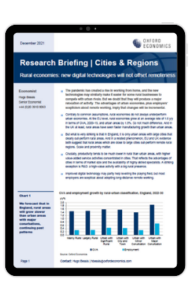Rural economies: new digital technologies will not offset remoteness

The pandemic has created a rise in working from home, and the new technologies may similarly make it easier for some rural businesses to compete with urban rivals. But we doubt that they will produce a major relocation of activity. The advantages of urban economies, plus employers’ scepticism about remote working, imply that changes will be incremental.
What you will learn:
- Rural economies do not always underperform urban economies. At the EU level, rural economies grew at an average rate of 1.6 y/y in terms of GVA, 2009-19, and urban areas by 1.8%. And in the UK at least, rural areas have seen faster manufacturing growth than urban areas.
- Rural areas which are close to large cities tend to out-perform remote rural regions. And productivity tends to be much lower in rural than urban areas, reflecting the advantages of cities in terms of market size and the availability of highly skilled specialists.
- Improved digital technology may partly help levelling the playing field, but most employers are sceptical about adopting long-distance remote working.
{% video_player “embed_player” overrideable=False, type=’scriptV4′, hide_playlist=True, viral_sharing=False, embed_button=False, autoplay=True, hidden_controls=False, loop=False, muted=False, full_width=False, width=’1920′, height=’1080′, player_id=’50853623338′, style=”, conversion_asset='{“type”:”CTA”,”id”:”25e94432-b880-454e-b731-3b2432b8cab8″,”position”:”POST”}’ %}
Tags:
Related Services

Post
US Key Themes 2026: Exceptionalism amid fragmentation
US exceptionalism is alive and well, and that won't change in 2026.
Find Out More
Post
Global Key themes 2026: Bullish on US despite AI bubble fears
We anticipate another year of broadly steady and unexceptional global GDP growth, but with some more interesting stories running below the surface.
Find Out More